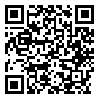Volume 8, Issue 28 (7-2017)
jemr 2017, 8(28): 161-190 |
Back to browse issues page
1- Allameh Tabatabai University , salem207@yahoo.com
2- University of Tehran
2- University of Tehran
Abstract: (4638 Views)
Religious tourism is very important either in Iran and in the international level. In this study dynamic linear almost ideal demand system and formulas of price and income elasticity were applied to estimate demand for religious trips. To this end, micro data of household budget prepared by Census center of Iran for 1991-2011 has been applied in this study.
According to the results, income elasticity of religious trips is about 0/42 , that means one percent increase in income will lead to an increase of 0/4 percent in demand for religious trips. Also the price elasticity of demand in all commodity groups is negative and price elasticity of religious trips is about -0/98.
According to the results, income elasticity of religious trips is about 0/42 , that means one percent increase in income will lead to an increase of 0/4 percent in demand for religious trips. Also the price elasticity of demand in all commodity groups is negative and price elasticity of religious trips is about -0/98.
Keywords: Religious Tourism, Dynamic Linear Almost Ideal Demand System, Price Elasticity, Income Elasticity
Type of Study: Applicable |
Subject:
اسلامی
Received: 2016/12/25 | Accepted: 2017/07/11 | Published: 2017/09/17
Received: 2016/12/25 | Accepted: 2017/07/11 | Published: 2017/09/17
References
1. Abbasi Nezhad, H., & Habibi, F. (2006). Analyzing and Estimating Iran Tourism Demand Function with Panel Data. Journal of Economic Research, 40(3), 91-115.
2. Alston Julian M, Foster Kenneth A, Gree Richard D (1994) "Estimating Elasticities with the Linear Approximate Almost Ideal Demand System: Some Monte Carlo Results". The Review of Economics and Statistics, Vol. 76, No. 2. [DOI:10.2307/2109891]
3. Amin, M.M. (2013), Religious Tourism in Egypt: A Case Study Analysis, the American University in Cairo, School of Global Affairs and Public Policy.
4. Badri, S.A., & Tayyebi, S. (2012). Factors affecting the costs of religious tourism: A case study of Mashhad, Iran. The Journal of Tourism Planning and Development, 1, 153-177.
5. Deaton, A., Muellbauer, J. (1980). An Almost Ideal Demand System. The American Economic Review, 70(3). 312-326
6. Golelaleh, Manoochehr; The Estimation of Iran's Tourism Demand Function; Master's Thesis of Faculty of Economics; Tehran. University of Allameh Tabataba'i. 2009.
7. Kwiatkowski, D., Phillips, P.C.B., Schmidt, P., Shin, Y. (1992). Testing the Null Hypothesis of Stationarity Against the Alternative of a Unit Root. Journal of Econometrics, 54, 159-178. [DOI:10.1016/0304-4076(92)90104-Y]
8. LI, G., SONG, H., WITT, S.F. (2004). Modelling Tourism Demand: A Dynamic Linear AIDS Approach. Journal of Travel Research , 43, 141-150. [DOI:10.1177/0047287504268235]
9. Meyer, G. (2004). New Research Network for Islamic Tourism. Islamic Tourism, 11, 42-57.
10. Modafri, A., Brorsen, B.W. (1993). Demand for Red Meat ,Poulatry and Fish in Morocco:An Almost Ideal Demand system. Agricultural Economics, 9,155-163. [DOI:10.1016/0169-5150(93)90010-A]
11. Mohammadi, T., Karimi, M., Najarzadeh, N., Shahkaram oghli, M. (2010). Factors Affecting Demand for Tourism in Iran. Journal of Financial Economy, 10, 114-142.
12. Mohammadzadeh, P., Behbudi, D., Mamipour, S., Feshari, M. (2010). Estimation of Foreign Iran's Tourism Demand from some Origin Countries (Time-Varying Parameter Approach). Journal of Quantitative Economics, 7(2), 149-171.
13. Momenei, M., Sarafei, M., Ghasemei, M. (2008). The Structure and Function of Religious-Cultural Tourism and the Necessity of Integrated Management in Mashhad Metropolis. Geography And Development Iranian Journal, 6(11), 13-38.
14. Musaee, M. (2004). Estimation of Tourism Demand for Iran. Journal of Trade Studies, 8, 225-244.
15. Rougier, J. (1997). A Simple Necessary Condition for Negativity in the Almost Ideal Demand System with the Stone Price Index. Applied Economic Letters, 4, 97-99 [DOI:10.1080/758526703]
16. Suleiman, J., Hardan, S., Badaruddin, M. (2011). Factors Impact on Religious Tourism Market: The Case of the Palestinian Territories. International Journal of Business and Management 6( 7), 254-260 [DOI:10.5539/ijbm.v6n7p254]
17. UNWTO, (2015), Tourism Highlights 2015 Edition, Available in "www.unwto.com".
18. Yang, Y., Liu, Z.H., Qi, Q. (2012). Domestic tourism demand of urban and rural residents in China: Does relative income matter?. Tourism Management, 40, 193-202. [DOI:10.1016/j.tourman.2013.05.005]
19. Zellner, A. (1962). An Efficient Method of Estimating Seemingly Unrelated Regressions and Tests forAggregation Bias. Journal of the American Statistical Association, 57, 348-368. [DOI:10.1080/01621459.1962.10480664]
| Rights and permissions | |
 | This work is licensed under a Creative Commons Attribution-NonCommercial 4.0 International License. |




